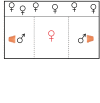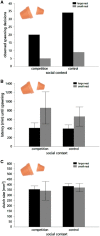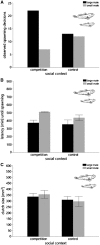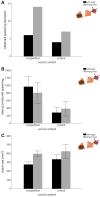Female mating competition alters female mating preferences in common gobies
- PMID: 30402078
- PMCID: PMC6007595
- DOI: 10.1093/cz/zoy024
Female mating competition alters female mating preferences in common gobies
Abstract
Mating decisions can be affected by intrasexual competition and sensitive to operational sex-ratio (OSR) changes in the population. Conceptually, it is assumed that both male and female mate-competition may interfere with female reproductive decisions. Experimentally, however, the focus has been on the effect of male competition on mate choice. In many species with paternal care as in the common goby Pomatoschistus microps, the OSR is often female-biased and female mate-competition for access to available nesting males occurs. Using the same protocol for 3 experiments testing the effect of a perceived risk of female mate-competition, I studied female preferences for nest-holding males differing in its nest size (large/small), body size (large/small), and nest status (with/without eggs already in nest) and measured mating decisions, spawning latencies, and clutch size. Regardless of the social context, females preferred males with larger nests. A preference for large males was only expressed in presence of additional females. For nest status, there was a tendency for females to prefer mating with males with an empty nest. Here, female-female competition increased the propensity to mate. The results of this study show that females are sensitive to a female competitive social environment and suggest that in choice situations, females respond to the social context mainly by mating decisions per se rather than by adjusting the clutch size or spawning latency. Females base their mating decisions not only on a male's nest size but also on male size as an additional cue of mate quality in the presence of additional females.
Keywords: Pomatoschistus microps; audience effect; intrasexual competition; mate sampling; parental care; sex-roles; size.
Figures





Similar articles
-
Male and female preferences for nest characteristics under paternal care.Ecol Evol. 2019 Jun 17;9(13):7780-7791. doi: 10.1002/ece3.5363. eCollection 2019 Jul. Ecol Evol. 2019. PMID: 31346440 Free PMC article.
-
MODE OF SEXUAL SELECTION DETERMINED BY RESOURCE ABUNDANCE IN TWO SAND GOBY POPULATIONS.Evolution. 1996 Apr;50(2):646-654. doi: 10.1111/j.1558-5646.1996.tb03875.x. Evolution. 1996. PMID: 28568956
-
Understanding resource driven female-female competition: ovary and liver size in sand gobies.R Soc Open Sci. 2019 Sep 11;6(9):190886. doi: 10.1098/rsos.190886. eCollection 2019 Sep. R Soc Open Sci. 2019. PMID: 31598312 Free PMC article.
-
The evolution of male mate choice in insects: a synthesis of ideas and evidence.Biol Rev Camb Philos Soc. 2001 Aug;76(3):305-39. doi: 10.1017/s1464793101005693. Biol Rev Camb Philos Soc. 2001. PMID: 11569787 Review.
-
Variation in mate choice and mating preferences: a review of causes and consequences.Biol Rev Camb Philos Soc. 1997 May;72(2):283-327. doi: 10.1017/s0006323196005014. Biol Rev Camb Philos Soc. 1997. PMID: 9155244 Review.
Cited by
-
Male mate choice, female competition, and female ornaments as components of sexual selection.Curr Zool. 2018 Jun;64(3):321-322. doi: 10.1093/cz/zoy037. Epub 2018 May 3. Curr Zool. 2018. PMID: 30402074 Free PMC article. No abstract available.
-
How sexual and natural selection interact and shape the evolution of nests and nesting behaviour in fishes.Philos Trans R Soc Lond B Biol Sci. 2023 Aug 28;378(1884):20220139. doi: 10.1098/rstb.2022.0139. Epub 2023 Jul 10. Philos Trans R Soc Lond B Biol Sci. 2023. PMID: 37427477 Free PMC article. Review.
-
Male and female preferences for nest characteristics under paternal care.Ecol Evol. 2019 Jun 17;9(13):7780-7791. doi: 10.1002/ece3.5363. eCollection 2019 Jul. Ecol Evol. 2019. PMID: 31346440 Free PMC article.
References
-
- Ahnesjö I, Forsgren E, Kvarnemo C, 2008. Variation in sexual selection in fishes In: Magnhagen C, Braithwaite V, Forsgren E, Kapoor BG, editors. Fish Behaviour. Enfield: Science Publishers, 303–336.
-
- Almada VC, Goncalves EJ, Oliveira RF, Santos AJ, 1995. Courting females: ecological constraints affect sex-roles in a natural population of the Blenniid fish Salaria pavo. Anim Behav 49:1125–1127.
-
- Amorim MCP, da Ponte AN, Caiano M, Pedroso SS, Pereira R. et al., 2013. Mate preference in the painted goby: the influence of visual and acoustic courtship signals. J Exp Biol 216:3996–4004. - PubMed
-
- Andersson M, 1994. Sexual Selection. Princeton: Princeton University Press.
LinkOut - more resources
Full Text Sources
